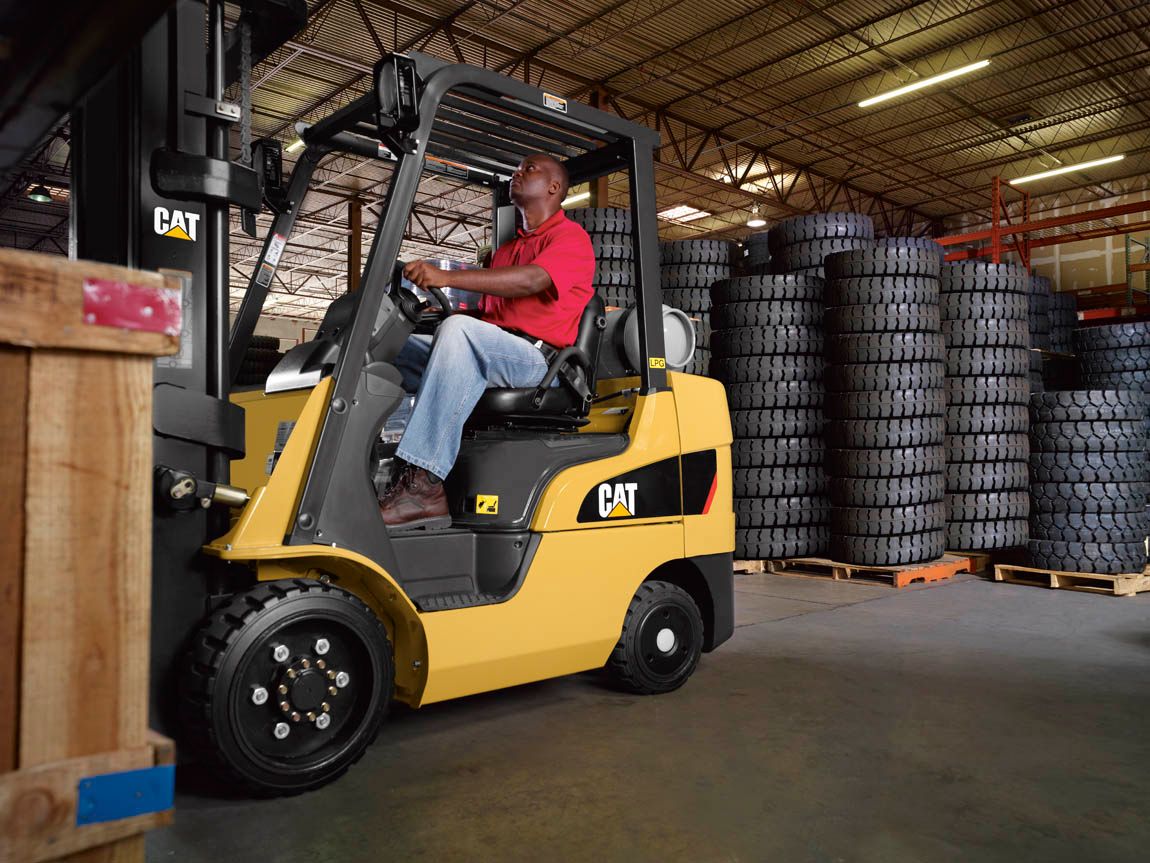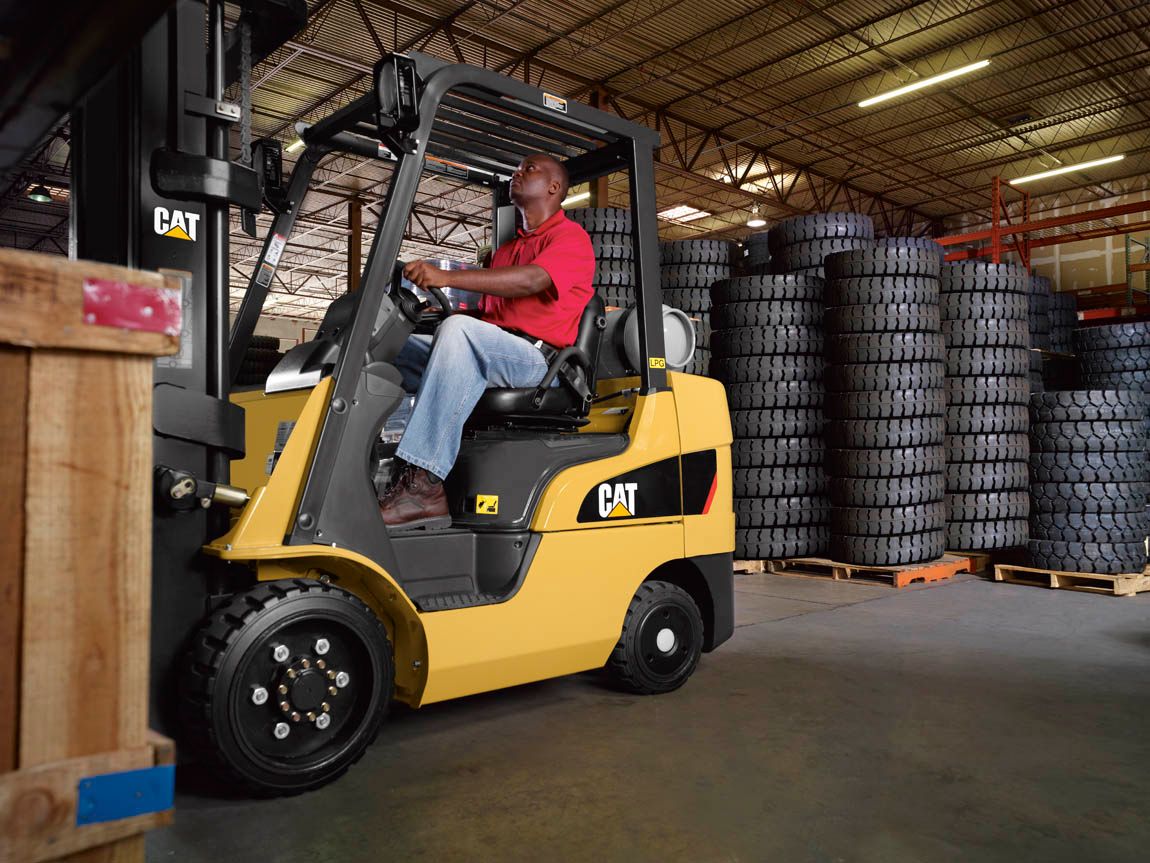

Sign In
Welcome! Sign In to personalize your Cat.com experience
If you already have an existing account with another Cat App, you can use the same account to sign in here
Register Now
One Account. All of Cat.
Your Caterpillar account is the single account you use to log in to select services and applications we offer. Shop for parts and machines online, manage your fleet, go mobile, and more.
Account Information
Site Settings
Security
Author: Small Business Expert | July 7, 2021 | Topic: Used Equipment
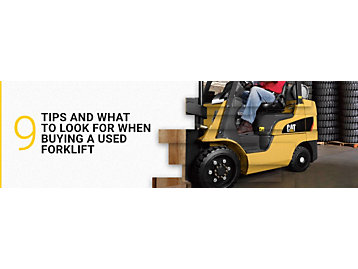
Forklifts play a crucial role in transporting pallets and other materials around a work site or warehouse. When you want to add more forklifts to your fleet, you may be interested in purchasing a used forklift. By buying used, you can receive high-quality machinery at a lower upfront cost. Since a used forklift has been employed by another owner, it's important to know how to inspect the forklift for damage and the main considerations to keep in mind when buying a used forklift.
Learn more about the benefits of buying a used forklift, what to look for when buying one and the nine inspection tips you can follow to ensure a forklift is in good condition before you make a purchase.
Benefits of Buying a Used Forklift
If you're interested in purchasing a used forklift, you might want to be aware of the top benefits of buying used forklifts. These advantages can make used forklifts very attractive to particular companies, as they help them save money and increase their buying power. Additionally, used forklifts can assist with speeding up the purchasing process and delivering reliable performance.
Here are some of the primary benefits of buying a used forklift:
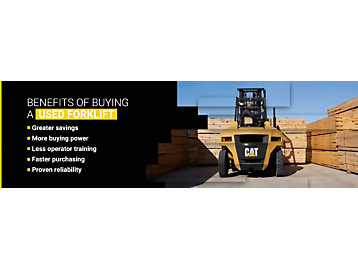
- Greater savings: Used forklifts come at a lower price point, allowing you to save money on upfront costs. Due to the cost-effective nature of used forklifts, you can free up your cash for other business ventures by buying them.
- More buying power: Due to the lower cost of used forklifts, you can often purchase multiple machines at the same time, giving you more buying power. If you want to expand your capabilities and increase productivity at your warehouse or work site, the ability to purchase multiple forklifts can assist with that goal.
- Faster purchasing: Used forklifts tend to be much faster to purchase, allowing you to close the deal and get back to work quicker. This fast purchasing process allows you to replace broken-down equipment with a new option quickly, reducing the amount of downtime you need to take into account while you wait for the right equipment.
- Proven reliability: When you select a used forklift, you can check its past history to ensure it has proven its reliability over time. If its history checks out, you can feel confident you're purchasing a durable forklift that can provide you with high-quality performance.
What to Consider When Buying a Used Forklift
Before you purchase a used forklift, you probably want to know what things to look for when buying a used forklift. While every company has different needs, you can ask a few common questions to help you narrow down the right forklift for your requirements. By knowing what questions to ask while you search for a forklift, you can make the most informed decision possible.
Here are some of the questions you may want to answer or have the seller answer before you buy a used forklift:
- What type of job will you need it for? One of the first steps you should take before purchasing a forklift is to determine what kinds of jobs you'll be using it for. For example, if you'll be using your forklift indoors, you'll need an electric forklift that won't emit gases in your space like propane-powered forklifts would emit.
- Does the forklift have a service history? When you go to purchase a forklift, you may want to see if the dealer or previous owner has the forklift's service history. This service history can be vital for your purchasing decision, as these histories can give you plenty of information about the vehicle's proper maintenance. Additionally, the forklift's service history can tell you if there were any recurring service issues or extensive operator misuse.
- Where was it used? Besides the service history, you can also review where the forklift was primarily used in the past. For example, if you know the previous owners used it near saltwater, you could expect more machine component corrosion. If they used it in humid environments, the electrical systems could experience more moisture, causing extra corrosion. Environmental factors like these can raise the chances you'll need to perform more maintenance on the forklift in the future.
- What size will you need? One of the tips for buying a used forklift is to evaluate what size you'll need the machine to be. Generally, a larger forklift will have more power, so if you have especially tough jobs, a larger forklift is often the better choice. However, warehouses with tight spaces between aisles may require smaller forklifts. You may also want forklifts with higher lifting capabilities if you need to deliver or pick up loads to or from high areas.
- How comfortable and safe is it? Your operators are going to spend a lot of time in the forklift's cab, so it should be comfortable. A forklift with good ergonomics can reduce the chance of operator injuries and make operation more pleasant for operators. Additionally, you can see if the forklift has high-quality safety features designed to keep your operators and other workers safe.
9 Inspection Tips for Used Forklifts
Before you invest in a used forklift, it's a good idea to follow some used forklift inspection tips to ensure it's in good condition. There are a few things to check before buying a used forklift to verify everything works appropriately and lasts a long time. When you inspect the forklift appropriately, you raise the chance you buy a forklift worth your money.
These are our top inspection tips for used forklifts:
1. Check the Lift Chains for Cracks and Missing Parts
One of the first things to check on a forklift is the condition of the lift chains attached to the mast. These chains are responsible for lifting or lowering the forks, along with any loads on them. Since they play such an essential role in the forklift, it's crucial to take care of them.
To inspect these lift chains, you can start at the bottom and work upwards, looking for any cracks in the chains that could cause the chain to break. You'll also want to search for welding marks indicating the cracks were repaired, as a bad welding job could harm the mast's structural integrity. Additionally, you can inspect the middle of the mast, ensuring it doesn't have any corroded or missing pins and links.
2. Look at the Forks for Damage
Another major inspection practice is to check the forks for damage. Forks are one of the most vital parts of a forklift, as they provide a stable platform for lifting pallets and other loads. To begin the inspection process, look closely at the forks to see if there are any signs of wear, such as bends and cracks. You'll need to pay special attention to cracks, as they're a major sign you'll need to replace the forks soon.
Another important step is to check the thickness of the fork blade's heel. You'll want to compare the heel's thickness to the upright fork shank's thickness. If you notice that the heel doesn't have the same thickness as the upright fork shank, it's a big sign the forks have experienced wear.
3. Review the Battery's Power
Forklifts need their battery to operate, but the hours left on the battery aren't tracked. Before you make a purchase, you can ask the previous owner how long the engine has been in operation and how many shifts it was used for during the day. Since standard batteries last around five years when used for only one shift a day, you can calculate how long the battery's power has left based on the previous owner's usage.
You'll also want to look at the battery's general condition, looking for signs of damage such as acid leaking and corrosion. You can open up the battery's cells to see if they have enough water. Check the battery's data plate to ensure it has the weight and size necessary for the lift it's installed in.
4. Inspect the Engine's Condition
To check the engine's condition, begin by starting the forklift and having it run for a few minutes. Next, switch off the forklift and open up the engine compartment. Look at the hoses, seeing if they have any cracks or leaks. After the previous steps, check the engine oil by pulling the dipstick out, with a low oil level potentially indicating the engine has a leak.
Inspect the belts to ensure they're well lubricated and tight, without any cracks or wear on them. You'll also want to ensure the engine has clean air filters. For electric forklifts, it's important to ensure the battery connection are secure and in good condition. If you have a propane-powered forklift, check the bolts and tank brackets' integrity.
5. Ensure the Mast Operates Smoothly
The mast needs to be in good condition to safely raise and lower materials from the forklift. Begin by having the seller raise the forks to verify the mast's condition. If you notice that the forks have issues raising, the link chain could be damaged, or the mast rollers may be worn down, with lopsided mast rollers being a major sign of wear. Additionally, you might find that the previous owner hasn't properly maintained or lubricated the mast rollers.
6. Search for Leaks
Any leaks around the forklift could be a sign of damage. Check for leaks around the radiator, mast cylinders and transmission. If you notice leaks, make a note of them as they will result in extra repairs for you if you make a purchase.
7. Evaluate the Tires' Conditions
A forklift's tires should be in good condition, as replacing them could result in extra costs after purchase. Begin by looking for signs of chunking, where the tire looks like a bite has been taken out of it. Additionally, cracks or punctures in the tires are signs of damage.
Next, you'll want to ensure the tires have lots of tread left on them, as low tread will mean you'll have to replace the tires soon. Check each tire's safety-line or wear line to see if a tire's tread has gone past them, indicating they need replacement. When the tires don't have wear lines, you can look at the sidewall's lettering to see if the tread has reached the top of the lettering. If it has, the tires need to be replaced.
8.Confirm the Odometer Reading
It's crucial to check a used forklift's odometer reading, as the number of hours on it can give you a rough estimate of how long it'll last after you purchase it. Alongside looking at the hours used and comparing them to information about how long the forklift typically lasts, you'll also want to verify the odometer hasn't been reset. If you notice lots of wear on the main components and the body, but the odometer shows a low reading, the previous owner may have tampered with the odometer.
9. Verify the Safety Features Function Properly
Before you purchase a used forklift, you should keep your operator's safety in mind. Inspect the forklift to ensure the seat adjustments, levers, brakes, horn, seatbelt and lights all work. You can also look at the overhead guard frame, checking for damage that could put an operator in harm's way.
Why Buy a Used Forklift From Cat Used?
As you look for a used forklift, it's a good idea to invest in a forklift from a reputable dealer. Many companies choose Cat Used to provide them with used Cat® forklifts due to the many advantages we provide. Find out more about the primary benefits of buying from us below:
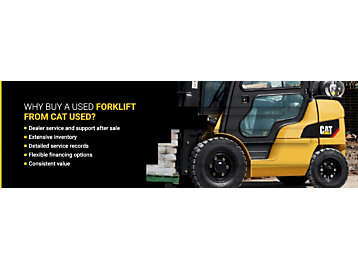
- Dealer service and support after sale: After you purchase a forklift from a Cat dealer, you can still expect to receive service and support. This support means we'll answer any questions you might have, provide you with aftermarket parts and assist with repairs.
- Extensive inventory: Cat Used is back by the entire Cat dealer network. Since we have a worldwide network, we can almost always find a used forklift meeting your needs.
- Detailed service records: Many of Cat Used's forklifts come with detailed service records. These records can tell you all about the forklift's previous history and verify it hasn't been misused or needed lots of repairs.
- Flexible financing options: Your Cat dealer can offer financial services designed to help you purchase a piece of equipment. Our flexible financing allows you to receive terms that work for your company and help you access the forklifts you need.
- Consistent value: Cat equipment is well-known and widely-used for a reason. It's some of the most durable equipment out there, meaning it retains its value for a long time. You can expect forklifts from Cat Used to provide you with top-tier performance far into the future.
Turn to Cat Used for Your Used Forklift Needs
Now that you've reviewed our used forklift buying guide and all of the benefits of buying from Cat Used and your local Cat dealer, you might be interested in purchasing a used forklift. You can browse our inventory of used diesel and electric forklifts today to find the best option for your needs.
If you have any questions, you can find your local dealer and contact them to learn more about a piece of equipment for sale. If the equipment you want isn't available, you can sign up for email alerts to know immediately when the equipment is available for purchase.
